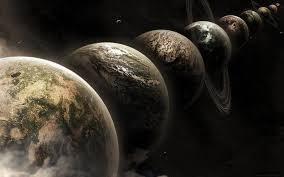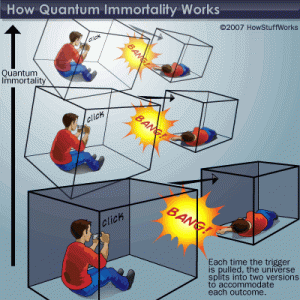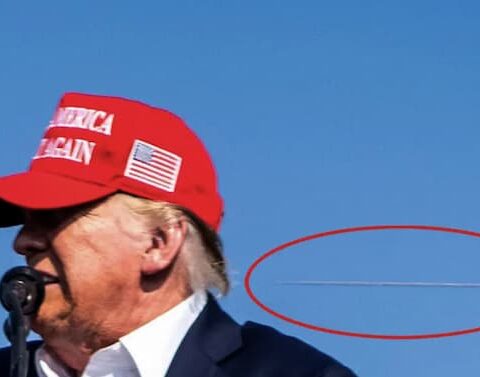Scientists conducting experiments at the Large Hadron Collider imminently ‘hope to connect with a Parallel Universe outside of our own’, according to excited headlines doing the rounds in recent weeks.
While I find it highly questionable whether any of the actual ‘scientists’ actually made that claim in quite those terms, the LHC ‘atom smasher’ at CERN in Geneva is being set to its highest energy levels to date in an apparent attempt to detect (or according to some, even to create) miniature black holes.
If successful, apparently a ‘completely new universe’ will be revealed, rewriting – according to some of the commentary – not only the physics books but the philosophy books too.
Or… everything gets sucked into this prospective mini black hole, never to be seen again.
But let’s give our scientists and physicists the benefit of the doubt and assume the possibilities of that happening are extremely low.
While all the ideas, implications and language spiralling out from this story are fascinating, it’s difficult for someone like myself to really tell how much of it is overly imaginative sensationalism from people trying to get hits on their videos or views on their articles, how much of it is exaggerated hyperbole to generate continuing interest in the LHC, and how much the experiments at CERN are genuinely on the verge of extraordinary breakthroughs in our understanding of the universe and reality… or days away from apocalyptic collapses of reality, multi-versal cave-ins and possible swarm-invasions of Interdimensional aliens into our world via Switzerland.
You know, whichever you prefer.
But who doesn’t get some level of perverse pleasure in watching newspapers and TV news reports (not to mention all the apocalypse enthusiasts and Rapture-philes) panicking with overwrought warnings about an impending apocalypse, as so many did when the LHC was first put into operation? Seriously, the one thing I would look forward to in any prospective End-of-the-world scenario is to see how the news channels cover it. Just imagine the rolling coverage when it emerges that a ‘black hole’ has manifested in Geneva. Or the radio call-ins that will follow; “Well, I blame it all on the liberals and their soft stance on immigration…” Or how Fox News is going to handle the Interdimensional invasion from demonic, Babylon 5 like Shadow entities as the news is breaking. You know, Walter Kronkite’s long gone, so who’s going to keep everybody calm when the War of the Worlds style mass panic, rioting and looting begins?
Actually, I’m being facetious, but I do have a predilection for this sort of stuff, no doubt in large part inherited from many years of enthusiasm for comic-books, science-fiction, and for various scientific or perhaps quasi-scientific literature (all otherwise known as Not Having a Girlfriend). Concepts of ‘Multi-Verses’, alternate realities, ‘Mirror Universes’, parallel dimensions, etc, are so embedded into the mindscape and lexicon of people like myself that we often forget just how extraordinary these things are when taken out of the realm of comic-books and science fiction and brought into real-world scientific experiments with potentially real-world effects and consequences.
“Unpredictable” would be an understatement.

The possibility of some kind of Iconian-type portal opening up at CERN and someone stepping through and ending up in an alternate-earth where the Roman Empire never fell and Centurions are riding around on motorbikes and eating Big-Macs is, we must imagine, very low; the best we might hope for is for discoveries to be made that would *theoretically* demonstrate the possibility, or even the probability, of the Many-Worlds Hypothesis being true.
Less exciting, but no less significant.
Some scientists, however, even consider it questionable whether any contemporary scientific experimentation is capable of measuring or revealing anything as extraordinary as the Many Worlds Hypothesis or telling us whether parallel worlds exist. According to Professor Mir Faizal from the University of Waterloo, “Normally, when people think of the multi-verse, they think of the many-worlds interpretation of quantum mechanics, where every possibility is actualized,” he said to Phys.org. “This cannot be tested and so it is philosophy and not science.”
As I see it (admittedly from a scientifically limited perspective), there’s another issue too; our perception of anything, and of reality itself, is subject to how our brains decode the information. For example, science informs us that the material world as we perceive it doesn’t actually exist; the way we perceive it is essentially a halfway-point or ‘compromise’ between our senses, our brains, and the actual reality itself, enabling us to function in the way that (presumably) best suits our needs or nature.
So how much of our perception of physics, space, the universe, etc, is subject to the limitations of our perception? That would also include our ability to measure things, to conduct or process scientific experiments and to decode all related information.
There have also, believe it or not, been some extraordinary observations made by quantum physicists in the past that nature at the atomic and quantum levels were found to *behave differently depending on whether they were being observed or not*; which is an extraordinary notion, bringing to mind the Toy Story gag of the child’s toys only ever doing their thing when the child is out of the room.
The ‘Many Worlds theory’ is also referred to as MWI, or the Relative State Formulation, the Everett Interpretation, the Theory of the Universal Wavefunction, Many-Universes Interpretation or just Many-Worlds. The original Relative State Formulation emerged via Hugh Everett in 1957. Not many ideas in theoretical physics capture the imagination as much as the many-worlds hypothesis, which proposes an infinite number of universes that differ from our own in ways both large and small; the concept has provided endless material for SF or comic-book writers for decades.

In fiction, the exploration of parallel world concepts is often tied up with that other prevailing (or cliched) trope of popular sci-fi: time travel. As Einstein would say, however, space, time and reality are inter-connected entities, each bound up in the other. However, where most interpretations have it that when you go back in time and alter something in the past you change the course of history and create an ‘altered timeline’, proponents of parallel-reality theories might argue that those ‘altered timelines’ in fact already exist anyway: that multiple, or even infinite, realities already exist side-by-side with our own and in which any or all variations of our existing history are already playing out.
There are some who argue that the Multi-Verse Theory, or at least the popular interpretation of it, is nonsense. The counter-argument is that none of us would exist in any parallel universe.
Not only would none of us exist, all things that we understand would not exist, as any parallel universe would have its own history, completely different from our history. For example, the asteroid that killed off the dinosaurs 65 million years ago would’ve never arrived. The history of our planet as we know it would not have transpired. More than that, the forces that allowed our planet to form would not exist because you would have to go all the way back to the formation of the universe to find the divergent point from this universe to any optional universe.
So if we did find an alternate universe, we wouldn’t be able to recognize it.
The most famous contemporary (ish) depiction of an alternate reality is Star Trek’s ‘Mirror Universe’ (with the famous goatee-sporting alternate Spock), appearing initially in the TOS episode ‘Mirror, Mirror’ and later more frequently explored in Deep Space Nine; but fanciful science fiction aside, many experts, including theoretical physicists, would refute that anything like that exists and would further argue that in any such ‘parallel universe’, there wouldn’t be a darker, goatee-wearing Spock, but in fact wouldn’t be any Spock at all – in a parallel world, the circumstances wouldn’t have unfolded to allow ‘Spock’ to even be born. In fact, Spock’s entire race might not have existed.

There is perhaps a degree of naivety (or wistfulness) in the kind of parallel worlds we find in comics, where although some things may be very different, people still have the same name, have the same people in their lives, etc. A parallel dimension could just as easily be one where the Universe as we know it didn’t form or develop in the same way, or where the conditions didn’t come together in the precise way necessary for life on Earth, for example.
Even so, the Many-Worlds Hypothesis or general notions of parallel worlds have an almost romantic hold on the imagination.
For those uninitiated into the theories or ideas (or, like myself, only cognisant at the elementary level), I would refer you this piece by Josh Clark, outlining Everett’s thoughts; ‘The universe is literally duplicated, splitting into one universe for each possible outcome from the measurement. For example, say an object’s wave function is both a particle and a wave. When a physicist measures the particle, there are two possible outcomes: It will either be measured as a particle or a wave. This distinction makes Everett’s Many-Worlds theory a competitor of the Copenhagen interpretation as an explanation for quantum mechanics. When a physicist measures the object, the universe splits into two distinct universes to accommodate each of the possible outcomes. So a scientist in one universe finds that the object has been measured in wave form. The same scientist in the other universe measures the object as a particle. This also explains how one particle can be measured in more than one state.’
Everett’s Many-Worlds interpretation holds implications beyond the quantum level. The idea is that any action that has more than one possible outcome means that the universe splits when that action is taken (even when a person chooses not to take the action); in other words, if you’re trying to decide whether to order the cheese burger or the vegetarian option, whichever you decide on, both scenarios will play out in different worlds. This also means that if you have ever found yourself in a situation where death was a possible outcome, then in a universe parallel to ours, you are quite, quite dead; “dead as a door-knob,” to quote Ebeneezer Scrooge.
This is perhaps one reason some people find the Many-Worlds interpretation disturbing.
I’m not sure I find it so disturbing, however; I’ve always found the MWH more comforting, in fact. The idea that there could be multiple, other me’s out there following through on things I never did, exploring paths I never or might never go down, is somehow instinctively comforting.
There might be a world out there where I did end up with that particular girl, or where I succeeded at something I’ve failed at in his life. A world where The Phantom Menace was a universally celebrated masterpiece, or where you (yes, you) and I are right now sharing a drink while sat on a balcony of a vast Sky-City held aloft by anti-gravity technology and overlooking the Amalfi Coast.
Another disturbing (to some) aspect of the Many-Worlds interpretation is that it is seen to undermine our more comfortable concept of time as a linear construct. Imagine a timeline chart delineating the history of the English Civil War, for example. A linear model of time would give us a straight line showing us relevant events in the chronology; whereas a timeline based on the Many-Worlds Interpretation would show each possible outcome of each action taken. From there, each possible outcome of the actions taken (as a result of the original outcome) would be further delineated, branching out expansively and more resembling a genealogical family-tree chart than an easy-to-process chronology of events.

It would be considerably more complicated, but perhaps substantially more interesting.
So how could we ever know if the Many-Worlds theory is correct? At present, we can’t. But assurance that the interpretation is theoretically possible came in the late 1990s from a thought experiment called ‘Quantum Suicide’. You can learn more here about How Quantum Suicide Works; but it might blow your mind a little, so don a crash helmet. Quantum Suicide, as a thought experiment, was published by Hans Moravec in 1987 and Bruno Marchal in 1988 and was independently developed further by Max Tegmark in 1998. It attempts to distinguish between the Copenhagen interpretation of quantum mechanics and the Everett many-worlds interpretation by pursuing a variation of the famous Schrödinger’s Cat thought-experiment, but from the cat’s point of view.
“Quantum Immortality” refers to the subjective experience of surviving quantum suicide regardless of the odds. I like the sound of that; though in truth I might not have fully understood it (not to self: commit Quantum Suicide, it sounds intriguing).
Quantum mechanics, which govern the tiny world of subatomic particles, suggest ‘Daughter Universes’ as the way multiple realities might arise. For example, imagine you’re in the ‘Neo scenario’ as laid out in The Matrix; Morpheus gives you the choice of taking either the blue pill or the red pill. The universe as we currently understand it in the standard model (if there is such a thing) allows you two ‘daughter universes’; one in which you take the blue pill and one in which you go for the red.

As quantum mechanics sees the world in terms of probabilities rather than definite outcomes, the mathematics of this theory (which I’m not going to pretend to entirely understand) might suggest that all possible outcomes of a situation do occur — in their own separate universes. And in each universe there’s a version of you experiencing one or the other outcome (thinking all the while that yours is the only ‘reality’).
It might help to imagine you’re a novelist and instead of writing one definitive story, you write out a whole separate novel for every possible direction your story could go in (I’ve been floundering in the writing of my novels for a number of years now and the thought of doing that makes me physically ill).
The fact is also that different things operate at different ‘levels’ of existence. There are things that vibrate at different rates, things that exist in different frequency ranges and resonances; things we can perceive and measure and thing we can’t. In that context, the possible existence of different dimensions or parallel worlds seems perfectly possible, even logical.
That doesn’t mean, however, that we can detect or perceive them; not any more than someone whose television is tuned to the BBC can also watch CNN at the same time.
The possibility of multiple worlds co-existing but being outside of our perception range isn’t something that bothers or confounds me; you need to look at it like, again, television signals. There may be numerous television ‘channels’ or broadcast signals being picked up or decoded through your TV, but it can’t display all of them to you at once: it’s one or the other. However, all those other signals/frequencies aren’t ceasing to exist just because you’re not watching them – they’re still there and are still just as ‘real’ and just as rich-with-information as whatever the channel is you happen to be watching.
In other words, these multiple, separate streams of data or transmissions are coexisting with each other, not interfering with another; and may therefore be a fitting analogy for how the Many-World Hypothesis may work.
These kinds of ideas and possibilities have been thoroughly explored for decades of course in novels, novellas, comic-books and films, with everyone from the late Terry Pratchett to televisual Star Trek exploring parallel world or alt-reality concepts; such ideas have in fact been the basis for some of the most memorable or best-loved stories over the years.
Edwin A. Abbot’s seminal 1884 novel Flatland: A Romance of Many Dimensions explores a world of two dimensions inhabited by living squares, triangles and circles, called Flatland, with Pointland (no dimensions), Lineland (one dimension) and Spaceland (three dimensions). Isaac Asimov described Flatland as “the best introduction one can find into the manner of perceiving dimensions.” Asimov included, some of the greatest SF writers and pioneers were enamoured with the subject of parallel worlds. In his 1941 novelette Elsewhen, Robert A. Heinlein writes of a professor who trains his mind to move his body across timelines. He then hypnotizes his students so they can explore more of them together. Eventually each settles in the reality most suitable for him or her. Some of the worlds they visit are mundane, some very odd, and others follow science fiction or fantasy conventions.
Philip K. Dick’s 1962 book, The Man in the High Castle, explores an alternate history in which Nazi Germany and Imperial Japan won World War II. This book contained an example of “alternate-alternate” history, in that one of its characters is the author of a book depicting a reality in which the Allies won the war, itself divergent from real-world history in several aspects. While Isaac Asimov’s short story What If is about a couple who can explore alternate realities by means of a television-like device; a take on this same idea is also found in Asimov’s 1955 novel The End of Eternity. In that novel the “Eternals” can change the realities of the world, without people being aware of it.
The idea of a parallel world was famously first introduced in comic books with the publication of Flash #123 and the famous “Flash of Two Worlds”. It has subsequently been a common, largely used trope in the medium. Probably the medium to explore ideas of parallel universe and alternate realities the most has been comic-books. The absolutely classic Alan Moore graphic-novel Watchmen was set in an alternative history, in a 1985 where superheroes exist, the Vietnam War was won by the United States and Richard Nixon is in his fifth term as President.
Parallel universes in modern comics have become particularly convoluted and frequently visited, in part due to continuity problems faced by the biggest two publishers, Marvel and DC Comics. Both publishers have employed multi-verse and alternate reality/time-line concepts to fix various problems, as well as to refresh fictional chronologies and continuities that have been running for many decades, breathe new life into canons and introduce new characters or alternate-version characters. DC in particular periodically revisits the idea in major crossover storylines, such as Crisis on Infinite Earths and Infinite Crisis.

Marvel had a long-running popular series called What If that was devoted to exploring alternative realities in which famous Marvel stories play out differently to how they did in ‘our’ reality (I used to love that series). Marvel has also had many large crossover events which depicted an alternative universe, many springing from events in the X-Men books, such as Days of Future Past, the seminal Age Of Apocalypse storyline or 2006’s House Of M. This toying with multi-verses and alt-realities is so common now as to be something of a cliche, in fact.
The X-Men: Days of Future Past movie in fact deals with the creation of an altered timeline too; a new ‘reality’ created by interference with the past. Indeed, the very premise of the current Star Trek film franchise (from 2009 onward) is that it exists *in a parallel universe* or ‘daughter universe’: the stories we see in this new franchise exist as an alternate/parallel reality to the one we know from the previous Star Trek franchise. On television, Star Trek of course has a long history of toying with parallel worlds, mirror universes and multi-verses. Bread and Circuses, The Omega Glory, and the famous Mirror Mirror were some of the Star Trek: Original Series’ best known explorations of parallel universes or ‘convergent evolution’, but similar themes were played out in pretty much every subsequent incarnation of the Star Trek franchise.

Elsewhere, among many other examples of these ideas being explored, the cult British sci-fi/comedy series Red Dwarf had an episode in which the characters accidentally prevented the assassination of John F. Kennedy and caused an alternate reality to play out in which JFK survived (curiously, it wasn’t a very nice alternate world that was created), while The Simpsons, South Park, Family Guy and others have also had fun with the concepts; for example, the South Park episode where a nice Eric Cartman arrives from a parallel universe (complete with Spock-like goatee) is hilarious, while Family Guy in particular has toyed with time-travel, parallel worlds and alternate timelines at great length, spawning some of the show’s best loved episodes.
These contemporary pop-culture dalliances with parallel world concepts ensure in fact that the ideas and even terminologies enter into the language of a next generation and among people who generally don’t follow science or even necessarily read sci-fi or comic books.

The ‘genre’ in fact can be said to go much further back than even the pioneering SF writers. For example, the Roman writer Livy contemplated an alternative 4th century BC in which Alexander the Great expanded his empire westward instead of eastward. In it, he asks “What would have been the results for Rome if she had been engaged in war with Alexander?”
Livy concluded that the Romans would likely have defeated Alexander (of course). Livy’s musings demonstrate that the notion (to varying extents) of ‘parallel worlds’ or alternate realities have perhaps been part of our psyche for a long, long time.
It may be that this interest in these kinds of ideas is deeply housed in our collective psyche, either because it represents some sort of intuitive or subconscious ‘knowing’ on our part or because the possibility speaks to something deep in our nature or psychology.
Perhaps a desire to believe that however badly we screw up in this life, there might be another version of us out there (or many) getting it right. Or that there may be better worlds, better societies out there. Or much worse ones too – either could in some way be a comforting thought. When we consider that one of the great hang-ups of life, both on our specific, individual levels and on the broader societal levels, is that we often lament all the wasted potentiality, missed opportunity or lost possibilities that exist in the world, perhaps we would take some solace in the idea that every potentiality, every opportunity, every possibility is being played out somewhere.
It remains unlikely that any definitive ‘proof’ of parallel universes or worlds will emerge any time soon from CERN, but any discoveries that can further legitimize the idea on a theoretical level *would* represent a big shift in thinking and would, by necessity, encourage further study and experimentation in this area, which over time may provide more revelatory answers.





Reblogged this on unnecessary news from earth and commented:
It is very good article about the theory of multiple universes and its amazing effects, thank you for sharing us, Earthling friend:)
Thanks, you’re welcome, Mr Non-Earthling friend… 🙂